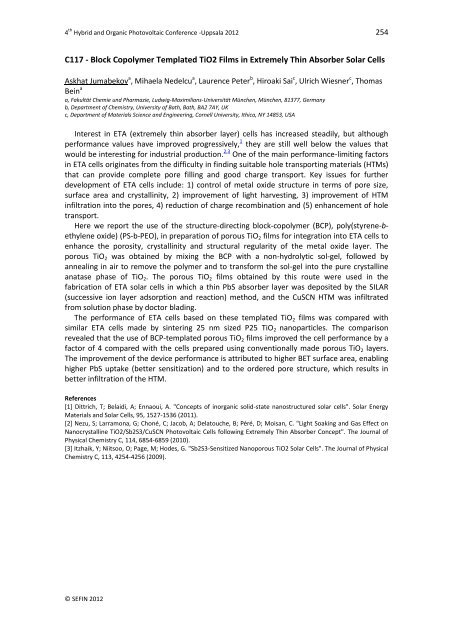HOPV12 - Blogs
HOPV12 - Blogs
HOPV12 - Blogs
Create successful ePaper yourself
Turn your PDF publications into a flip-book with our unique Google optimized e-Paper software.
4 th Hybrid and Organic Photovoltaic Conference -Uppsala 2012 254<br />
C117 - Block Copolymer Templated TiO2 Films in Extremely Thin Absorber Solar Cells<br />
Askhat Jumabekov a , Mihaela Nedelcu a , Laurence Peter b , Hiroaki Sai c , Ulrich Wiesner c , Thomas<br />
Bein a<br />
a, Fakultät Chemie und Pharmazie, Ludwig-Maximilians-Universität München, München, 81377, Germany<br />
b, Department of Chemistry, University of Bath, Bath, BA2 7AY, UK<br />
c, Department of Materials Science and Engineering, Cornell University, Ithica, NY 14853, USA<br />
Interest in ETA (extremely thin absorber layer) cells has increased steadily, but although<br />
performance values have improved progressively, 1 they are still well below the values that<br />
would be interesting for industrial production. 2,3 One of the main performance-limiting factors<br />
in ETA cells originates from the difficulty in finding suitable hole transporting materials (HTMs)<br />
that can provide complete pore filling and good charge transport. Key issues for further<br />
development of ETA cells include: 1) control of metal oxide structure in terms of pore size,<br />
surface area and crystallinity, 2) improvement of light harvesting, 3) improvement of HTM<br />
infiltration into the pores, 4) reduction of charge recombination and (5) enhancement of hole<br />
transport.<br />
Here we report the use of the structure-directing block-copolymer (BCP), poly(styrene-bethylene<br />
oxide) (PS-b-PEO), in preparation of porous TiO2 films for integration into ETA cells to<br />
enhance the porosity, crystallinity and structural regularity of the metal oxide layer. The<br />
porous TiO2 was obtained by mixing the BCP with a non-hydrolytic sol-gel, followed by<br />
annealing in air to remove the polymer and to transform the sol-gel into the pure crystalline<br />
anatase phase of TiO2. The porous TiO2 films obtained by this route were used in the<br />
fabrication of ETA solar cells in which a thin PbS absorber layer was deposited by the SILAR<br />
(successive ion layer adsorption and reaction) method, and the CuSCN HTM was infiltrated<br />
from solution phase by doctor blading.<br />
The performance of ETA cells based on these templated TiO2 films was compared with<br />
similar ETA cells made by sintering 25 nm sized P25 TiO2 nanoparticles. The comparison<br />
revealed that the use of BCP-templated porous TiO2 films improved the cell performance by a<br />
factor of 4 compared with the cells prepared using conventionally made porous TiO2 layers.<br />
The improvement of the device performance is attributed to higher BET surface area, enabling<br />
higher PbS uptake (better sensitization) and to the ordered pore structure, which results in<br />
better infiltration of the HTM.<br />
References<br />
[1] Dittrich, T; Belaidi, A; Ennaoui, A. "Concepts of inorganic solid-state nanostructured solar cells". Solar Energy<br />
Materials and Solar Cells, 95, 1527-1536 (2011).<br />
[2] Nezu, S; Larramona, G; Choné, C; Jacob, A; Delatouche, B; Péré, D; Moisan, C. "Light Soaking and Gas Effect on<br />
Nanocrystalline TiO2/Sb2S3/CuSCN Photovoltaic Cells following Extremely Thin Absorber Concept". The Journal of<br />
Physical Chemistry C, 114, 6854-6859 (2010).<br />
[3] Itzhaik, Y; Niitsoo, O; Page, M; Hodes, G. "Sb2S3-Sensitized Nanoporous TiO2 Solar Cells". The Journal of Physical<br />
Chemistry C, 113, 4254-4256 (2009).<br />
© SEFIN 2012


